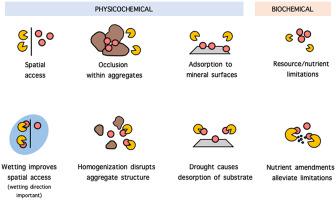Soil Biology and Biochemistry ( IF 9.8 ) Pub Date : 2021-09-20 , DOI: 10.1016/j.soilbio.2021.108427 Kaizad F. Patel 1 , A. Peyton Smith 2 , Ben Bond-Lamberty 3 , Sarah J. Fansler 1 , Malak M. Tfaily 4, 5 , Lisa Bramer 6 , Tamas Varga 5 , Vanessa L. Bailey 1

|
Core-scale soil carbon fluxes are ultimately regulated by pore-scale dynamics of substrate availability and microbial access. These are constrained by physicochemical and biochemical phenomena (e.g. spatial access and hydrologic connectivity, physical occlusion, adsorption-desorption with mineral surfaces, nutrient and resource limitations). We conducted an experiment to determine how spatial access and resource limitations influence core-scale water-soluble SOM mineralization, and how these are regulated by antecedent moisture conditions. Intact soil cores were incubated at field-moist vs. drought conditions, after which they were saturated from above (to simulate precipitation) or below (to simulate groundwater recharge). Soluble C (acetate) and N (nitrate) forms were added to some cores during the rewetting process to alleviate potential nutrient limitations. Soil respiration was measured during the incubation, after which pore water was extracted from the saturated soils and analyzed for water soluble organic carbon concentrations and characterization. Our results showed that C amendments increased the cumulative CO2 evolved from the soil cores, suggesting that the soils were C-limited. Drought and rewetting increased soil respiration, and there was a greater abundance of complex aromatic molecules in pore waters sampled from these soils. This newly available substrate appeared to alleviate nutrient limitations on respiration, because there were no further respiration increases with subsequent C and N amendments. We had hypothesized that respiration would be influenced by wetting direction, as simulated precipitation would mobilize C from the surface. However, as a main effect, this response was seen only in the C-amended soils, indicating that surface-C may not have been bioavailable. At the pore scale (pore water samples), drought and the C, N amendments caused a net loss of identified molecules when the soils were rewet from below, whereas wetting from above caused a net increase in identified molecules, suggesting that fresh inputs stimulated the C-and N-limited microbial populations present deeper in the soil profile. Our experiment highlights the complex and interactive role of antecedent moisture conditions, wetting direction, and resource limitations in driving core-scale C fluxes.
中文翻译:

空间准入和资源限制控制土壤中的碳矿化
核心尺度土壤碳通量最终受基质可用性和微生物进入的孔隙尺度动态调节。这些受到物理化学和生化现象的限制(例如空间通路和水文连通性、物理闭塞、矿物表面的吸附-解吸、养分和资源限制)。我们进行了一项实验,以确定空间访问和资源限制如何影响核心尺度水溶性 SOM 矿化,以及这些如何受先前水分条件的调节。完整的土壤核心在田间潮湿与干旱条件下孵育,然后从上方(模拟降水)或下方(模拟地下水补给)饱和。在再润湿过程中,可溶性 C(醋酸盐)和 N(硝酸盐)形式被添加到一些核心中,以减轻潜在的营养限制。在培养期间测量土壤呼吸,然后从饱和土壤中提取孔隙水并分析水溶性有机碳浓度和表征。我们的结果表明,C 修正增加了累积 CO2从土壤核心进化而来,表明土壤是 C 限制的。干旱和再湿润增加了土壤呼吸,并且在从这些土壤中取样的孔隙水中有更多的复杂芳香分子。这种新可用的底物似乎减轻了营养对呼吸的限制,因为随后的 C 和 N 修正没有进一步增加呼吸。我们假设呼吸会受到润湿方向的影响,因为模拟降水会从表面调动 C。然而,作为主要影响,这种反应仅在 C 修正的土壤中出现,表明表面 C 可能没有生物可利用性。在孔隙尺度(孔隙水样品)上,当土壤从下面重新润湿时,干旱和 C、N 修正会导致已识别分子的净损失,而从上方润湿导致已识别分子的净增加,这表明新鲜输入刺激了土壤剖面深处存在的 C 和 N 限制微生物种群。我们的实验强调了先前水分条件、润湿方向和资源限制在驱动核心尺度 C 通量方面的复杂和交互作用。











































 京公网安备 11010802027423号
京公网安备 11010802027423号